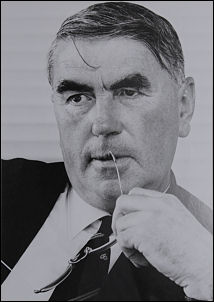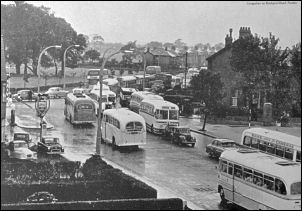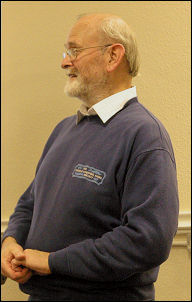|
|
|
Nov 2008 |
|
|
|
Sat 29
Nov 2008 |
|
The Dawn of the Motorway
Age.
M6 - 50 years of the Preston By-Pass - UK's first motorway. |
|
On the 5th Dec
1958 the Preston By-Pass opened. It was the UK’s first motorway
and this morning an exhibition to commemorate it was open at the
Museum of Lancashire, Stanley St., Preston. The scheme was
mostly thanks to Sir James Drake, Lancashire’s County Surveyor
and Bridge master. The world’s first motorway was opened in
Italy in 1924. Some other interesting facts are:
1923 The first roundabouts were created,
1927 A single white line was used to divide each side of the
road,
1930 Minimum driving age of 17 was set,
1935 1 June driving tests became compulsory,
1951 The first zebra crossing was introduced in Slough,
1967 The Annual MOT test for all cars over 3 years old replaces
the 10 year requirement introduced in 1960. |
 |
|

The exhibition opens. |
 |
|

Sir James Drake - County Surveyor and Bridge master |

Preston congestion before the
motorway age. |
| |
|
|
|
Thu 27
Nov 2008 |
|
Lizzie Jones at Astley Hall
presenting 'The Conspiring Countess' |
|
Lizzie Jones made
a very welcome return to Chorley and the magnificent main hall
of Astley Hall to present her performance of ‘The Conspiring
Countess’. The event was a ‘sell out’ and every seat in the hall
was taken.
The true story she told was all about Bess of Hardwick and her
rise from relatively humble beginnings to become one of the
wealthiest women in England. Her full name was Elizabeth Talbot,
Countess of Shrewsbury (1527 – 1608) and tonight’s presentation
marked the 400th anniversary of her death. Bess was the third
daughter of John Hardwick and was married for the first time to
Richard Barlow at the early age of 13, Richard was of a similar
age but sadly didn’t live long after the marriage and died in
his teens leaving Bess a very wealthy teenager. She married for
the second time to Sir William Cavendish who was more than 20
years older than she was. They had 8 children but only 4
survived infancy. Sir William died in 1557 and left Bess even
wealthier but she had to re-marry quickly to preserve her
wealth. |

Bess of Hardwick c1550 |
|

Lizzie Jones as Bess of Hardwick |
In 1559 Bess
married Sir William Loe, who was Captain of the Guard to Queen
Elizabeth I. Unfortunately Sir William died 5 years later
leaving Bess even richer still. Bess was also Lady in Waiting to
Queen Elizabeth I and at times was imprisoned by her for
associations with others. In 1567 Bess married George Talbot,
6th Earl of Shrewsbury - an extremely rich and powerful man.
Shortly after George Talbot was made the guardian of Mary Queen
of Scots which for 15 years inflicted a considerable financial
drain on their finances. He complained of the £20 per day
expenses and even £1000 per year for wine to quench the thirst
of Mary’s entourage. The whole affair was strictly controlled by
Elizabeth I who would not allow any visitors or travelling
without her permission. Bess continued her conspiring ways by
arranging a meeting and subsequent controversial marriage
between her granddaughter Arabella and Lord Denbigh. Arbella
Stuart was raised by her grandmother Bess of Hardwick. Queen
Elizabeth I had indicated that Arbella might be named her heir
and Bess raised Arbella extremely strictly believing that her
granddaughter was destined to become the next Queen of England. |
|
Bess was
ambitious and arranged the betrothal of the 8 year old Arbella
to Lord Denbigh, the two year old son of the Earl of Leicester
and Lettice Knollys. Queen Elizabeth was furious. The
relationship between Bess and Arbella completely deteriorated.
Arbella was so restricted by Bess that she felt like a prisoner.
Arbella never became Queen of England.
In 1590 George Talbot, the Earl of Shrewsbury died. The marriage
between himself and Bess had been a bitter and unhappy one. He
had described Bess as “that sharp bitter shrew”. Bess became the
richest woman in England, second only to Queen Elizabeth. Bess
built her magnificent home called Hardwick Hall and was referred
to as Bess of Hardwick. She died there on 13th February 1608.
Wine and mince pies rounded the evening off nicely. |
 |
|
|
Tue 11
Nov 2008 |
|
Mike Clarke presents
'Lancashire's Earliest Canals' |
|
Mike
Clarke made a very welcome return to present “The Duke
of Bridgewater – The Father of British Canals?” The
question mark on the end of the title was to indicate
some doubt about his effect on the canal. Mike began by
explaining the origins of the canal system of
transportation that emerged after the Roman Empire. They
are generally agreed to have started under the rule of
Charlemagne in Bavaria in 793AD. The canal system was
quite extensive in Europe when Britain stated to use
them. In 1600 we had 700 miles of canals and by 1760
they had expanded to 1300 miles. |

Mike Clarke |
|

Charlemagn and Pope Adrian. |
Mike then
spoke about the Bridgewater Canal, commissioned by
Francis Egerton, 3rd Duke of Bridgewater. It connected
Runcorn, Manchester and Leigh and was used to transport
coal from his mines in Worsley to Manchester. It was
opened in 1761 from Worsley to Manchester and later
extended from Manchester to Runcorn, and then from
Worsley to Leigh. By examining the economic development
through the country at the time it was interesting to
note that developments elsewhere were just as important
as those instigated by the Duke of Bridgewater. The
north of England and in particular Lancashire was also
shown to be the economic powerhouse of the country; with
the cotton / textile industry producing 10 times more
money for the economy than the coal industry and 3 times
more money than iron and steel industry. |
|
After the
talk Mike spoke briefly about the information marker
posts that had been erected along the Leeds and
Liverpool canal at Johnson's Hillock, Whittle-le-Woods.
They illustrated the working of various aspects of barge
hauling and the operation of the locks both as
descriptive text and three dimensional reliefs. Several
members had seen them and been impressed by their
usefulness. They were erected with grant aided funding
and more were needed along the canal. If people thought
they were a good idea he asked that we write to Nick
Smith at British Waterways, Waterside House, Waterside
Drive, Wigan. WN3 5AZ. |
|
|
|
|
|
|